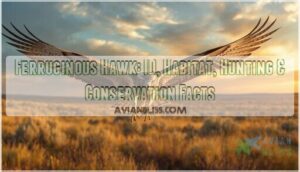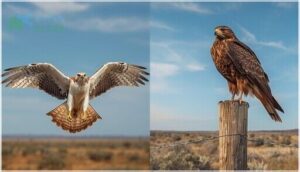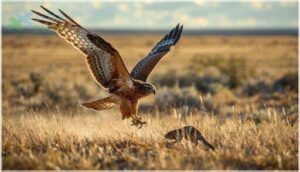This site is supported by our readers. We may earn a commission, at no cost to you, if you purchase through links.

When a raptor the size of a red-tailed hawk can take down a full-grown jackrabbit in open country, you’re witnessing the ferruginous hawk at work. This powerhouse of the grasslands represents North America’s largest buteo, with females tipping the scales at nearly four pounds and wingspans stretching beyond five feet.
Yet despite its formidable presence across western rangelands, this species has lost half its historical range since 1900, retreating as native prairies vanished beneath the plow. You’ll find these rust-streaked raptors soaring over sagebrush flats and shortgrass prairie, where their feathered legs—extending all the way to their toes—distinguish them from every other hawk on the continent.
Table Of Contents
- Key Takeaways
- Ferruginous Hawk Identification
- Habitat and Geographic Range
- Hunting Behavior and Diet
- Reproduction and Life Cycle
- Conservation Status and Threats
- Frequently Asked Questions (FAQs)
- Where do ferruginous hawks live?
- Do ferruginous hawks eat golden eagles?
- How do ferruginous hawks hunt?
- What does a ferruginous hawk look like?
- Is a Ferruginous Hawk bigger than a bald eagle?
- How do you identify a Ferruginous Hawk?
- What is the difference between a Red-tailed Hawk and a Ferruginous Hawk?
- What is the meaning of Ferruginous Hawk?
- How long do ferruginous hawks typically live?
- Do ferruginous hawks have any natural predators?
- Conclusion
Key Takeaways
- Ferruginous hawks, North America’s largest buteo with wingspans exceeding five feet, have lost half their historical range since 1900 due to prairie conversion to agriculture, making habitat preservation critical for their survival.
- These raptors demonstrate exceptional hunting adaptability through multiple strategies—ground strikes yield 26% success rates while their diet shifts seasonally between ground squirrels (95% in breeding season) and jackrabbits depending on prey availability.
- Sexual size dimorphism drives distinct breeding roles where females outweigh males by 1.5 times and handle nest duties while males deliver 72% of prey items, resulting in fledging success rates around 67% in occupied territories.
- Conservation faces compounding threats as climate extremes destroy nests, human disturbance forces abandonment within 0.7 km of buildings, and toxic substances from lead ammunition undermine populations that have crashed 64% in some regions like Alberta.
Ferruginous Hawk Identification
You’ll know a Ferruginous Hawk when you see one—if you know what to look for. These large raptors have distinct features that set them apart from other hawks cruising the open grasslands.
Here’s what makes them unmistakable in the field.
Size and Wingspan Characteristics
When you’re scanning western skies for Buteo regalis, size matters. The ferruginous hawk ranks as North America’s largest buteo, commanding attention with body length reaching 50–71 cm and wingspans stretching 122–158 cm. These aerodynamic features deliver serious hunting advantages:
- Males average 1,050–1,163 g; females tip scales at 1,231–1,776 g
- Wing structure enables smooth soaring across open rangelands
- Feather adaptation includes leg feathering extending to toes for thermal regulation
Understanding their habitat conservation is vital for their survival.
Coloration and Plumage Variations
You’ll spot two distinct morph types in the field—light morphs dominate at roughly 90% of the population, while dark morphs account for the remaining 10%.
Light morph Ferruginous Hawks flash white underparts with rusty leg feathering, forming that signature V-pattern overhead. Dark morphs wear uniform rufous-chocolate plumage with pale flight feathers, creating dramatic contrast against western skies.
Understanding the raptor id guides is essential for accurate identification of these birds.
Unique Head, Bill, and Feathered Legs
Beyond color, you’ll recognize Ferruginous Hawks by their eagle-like profile—that oversized head and massive bill set them apart from other buteos. Their legs wear feathers straight down to the toes, like built-in chaps protecting against thorny grasslands. This “booted” look, combined with their pale head and wide gape, makes light morph identification unmistakable in the field.
- Large head creates distinctive eagle-like silhouette
- Bill measures 37.6-49.5 mm, largest among North American buteos
- Feathered legs extend fully to toes for protection
- Wide gape (42.7-57 mm) enables handling large prey
- Pale head contrasts sharply with rusty shoulders and legs
Differences Between Male and Female
You won’t spot male-female differences in plumage—both sexes wear identical markings. However, sexual size dimorphism tells the real story: females weigh up to 1.5 times more than males, averaging 1,776 grams versus males’ 1,163 grams.
This reversed dimorphism drives distinct breeding roles—males deliver 72% of prey items while females handle nest duties. Sex identification methods require weight measurements or genetic analysis, not field observation alone.
Comparison to Similar Raptors
You’ll distinguish Ferruginous Hawks from other Buteo species by their massive wingspan—53 to 56 inches—larger than Red-tailed Hawks and Swainson’s Hawk but smaller than Golden Eagles. During hawk migration, watch for their rusty “leggings” and white underwing patches, features absent in similar raptor species.
Raptors conservation efforts benefit from accurate Buteo hawks identification, especially in shared winter roosts with other raptor species.
Habitat and Geographic Range
You’ll find ferruginous hawks across the wide-open spaces of western North America, where vast grasslands and shrublands stretch to the horizon. These raptors have carved out a niche in some of the continent’s most unforgiving terrain, thriving where others struggle.
Let’s break down where they live, how far they roam, and what makes these landscapes perfect for North America’s largest buteo.
Preferred Ecosystems and Landscapes
You’ll find Ferruginous Hawks commanding the West’s most expansive open territories. These raptors thrive where freedom meets function in grassland ecology and shrub steppe mosaics. Their preferred wildlife habitat includes:
- Native and tame grasslands with sparse tree cover for nesting
- Sagebrush ecosystems and arid landscapes with rabbit populations
- Open habitats featuring lone trees, rocky outcrops, or fence posts
- Mixed shrub-grassland complexes dominated by big sagebrush
- Conservation Reserve Program (CRP) lands supporting abundant prey availability
Habitat preservation efforts focus on maintaining these open, prey-rich ecosystems critical for avian habitat preservation.
Distribution in North America
You’ll encounter the Ferruginous Hawk across western North America’s vast open territories, where the geographic range stretches from southern Canada through the Great Plains. Breeding patterns concentrate in grasslands from Alberta to Texas, while the habitat range extends west to California’s deserts and east through the Prairies. Population dynamics reveal distinct territories separated by roughly half a mile in prime habitat.
Migration routes guide southern populations to northern Mexico, though some become year-round residents in warmer zones.
| Region | Breeding Territory | Habitat Preferences |
|---|---|---|
| Northern Core | Alberta to Manitoba | Native grasslands, sagebrush steppe |
| Central Plains | Dakotas to Kansas | Open range with sparse cultivation |
| Western Edge | California to Oregon | Deserts, shrub country, minimal forest |
Seasonal Migration Patterns
Migration patterns in Ferruginous Hawks reveal impressive navigational prowess—approximately 98% of adults undertake seasonal journeys averaging 2,376 km annually.
You’ll observe hawks east of the Continental Divide traveling south to New Mexico, while western populations cross geographic barriers eastward to grasslands before reversing course to California wintering grounds.
Migration routes follow prey availability closely, with flight speeds reaching 90 km/hr and hawks covering up to 122 km daily during spring movements.
Adaptations to Arid Environments
You’ll find Ferruginous Hawks thriving where water conservation becomes a survival art—they successfully breed in arid landscapes with minimal dependency on open water sources, relying instead on specialized adaptations:
- Thermoregulation through elevated perches and broad-winged soaring reduces heat stress
- Dietary adaptations favor drought-tolerant prey like ground squirrels and jackrabbits
- Nesting strategies exploit geological formations and sparse vegetation for microclimate control
- Opportunistic hunting at burrow entrances maximizes arid survival efficiency
- Structural flexibility allows platform use where habitat degradation limits natural sites
These raptor biology innovations demonstrate exceptional resilience against environmental extremes.
Hunting Behavior and Diet
Ferruginous Hawks are formidable hunters, specializing in the small mammals that dominate their open grassland territories.
You’ll find these raptors using a mix of patience and aerial prowess to secure their next meal. Let’s break down what they hunt, how they do it, and what makes them so effective at catching prey.
Primary Prey Species
You’ll find the Ferruginous Hawk diet dominated by small mammals that form the backbone of grassland food chains. Jackrabbits and cottontails can comprise over 95% of prey biomass in shrub-steppe regions, while ground squirrels may represent 54% of nestling provisions during peak years.
This predator relies heavily on prairie dogs, hares, and fossorial rodents, with prey population dynamics directly influencing hunting strategies and reproductive success across its range.
Hunting Techniques and Strategies
Your Ferruginous Hawk masters hunting tactics with strategic brilliance you’d expect from a prairie predator. Ground strikes deliver the highest success at 26.2%, while perch hunting from fence posts yields 9.2% efficiency. Aerial pursuits include low-altitude approaches (12.7% success) and high-altitude dives (20.8% success). These prey ambush techniques reveal adaptive mastery:
- Ground hunting targets burrow entrances within 1-meter strikes
- Perch hunting covers 10-100+ meter attack distances
- Low flight attacks execute below 30-meter altitudes
- High-altitude hovering facilitates precision plunge descents
- Overall hunting efficiency averages 14.8% across methods
Seasonal Variations in Diet
You’ll witness dramatic dietary shifts as prey availability changes throughout the year. During the breeding season east of the Rockies, ground squirrels dominate up to 95% of your hawk’s diet, while winter populations west of the Continental Divide rely heavily on jackrabbits and cottontails.
These foraging strategies showcase impressive hunting adaptations—your ferruginous hawk adjusts timing and tactics, pursuing crepuscular lagomorphs at dawn and dusk when seasonal migration patterns influence raptor ecology across North American grasslands.
Adaptations for Efficient Predation
Your raptor’s morphological traits—powerful talons, feathered legs, and a 127-152 cm wingspan—combine with outstanding sensory abilities for precision strikes. These hunting strategies include perch ambushes and low-level flight patterns that boost prey capture efficiency.
Watch how the hawk’s acute vision spots mammals from hundreds of meters up, while mechanoreceptive facial hairs sharpen tactile feedback during handling—classic avian behavior optimizing this bird of prey‘s predation success.
Reproduction and Life Cycle
Ferruginous hawks follow a breeding cycle tied closely to the availability of prey across their grassland territories. From selecting towering nest sites to raising their young through fledging, these raptors demonstrate exceptional adaptability in some of North America’s most challenging environments.
Here’s what you need to know about their reproductive strategy and life stages.
Nest Site Selection and Construction
Regarding claiming prime real estate, you’ll find Ferruginous Hawks aren’t picky about substrate—they’re strategic. These raptors select elevated sites offering visibility and prey access, building bulky structures from twigs, roots, and even bones.
Key nesting choices include:
- Tree nesting in cottonwoods or junipers (2-17 meters high)
- Rock outcrop selection on cliffs and erosional pillars
- Anthropogenic nesting on powerlines and artificial platforms
- Nest material gathering using unconventional items like livestock dung
Nest platform design emphasizes durability for reuse across seasons.
Mating and Pair Bonding
Sky-bound acrobatics define Ferruginous Hawk courtship rituals as males perform dramatic dives and ascents while pairs clasp talons mid-flight. These hawks demonstrate monogamous behavior that usually lasts for life, supporting outstanding breeding success through cooperative hunting and nest defense.
| Pair Formation Aspect | Behavioral Pattern |
|---|---|
| Courtship displays | Sky dances with talon-grasping spirals |
| Mate fidelity | Long-term bonds, often lifelong |
| Breeding roles | Shared incubation and provisioning |
| Territory defense | Aggressive intruder chasing |
| Bond duration | Year-round in many pairs |
These hawk species exhibit impressive commitment to pair formation, with both partners defending their territory through open-talon attacks. They maintain cooperative nesting behavior, which maximizes reproductive output.
Egg Laying and Chick Development
You’ll find Ferruginous Hawk nesting behavior fascinating as females usually lay 3 to 4 eggs between April and early May, with reddish-brown speckled shells measuring about 2.4 inches long. Egg incubation spans 32 to 33 days, shared between both parents. Chick growth progresses rapidly, with nestling care demanding intense parental provisioning—males deliver 72% of prey.
Watch for these breeding habits milestones:
- Hatchlings emerge helpless with downy feathers in late May
- Nestlings begin self-feeding around 16-18 days after hatching
- Male chicks typically grow faster than females during development
- Parents provide approximately 93 grams of prey per hour
- Fledging success rates range from 1.07 to 3.5 young per nest
This bird species identification marker—extended parental investment—directly impacts Ferruginous Hawk conservation outcomes and population stability across their range.
Fledging and Juvenile Dispersal
You’ll witness young Ferruginous Hawks leave the nest after 38-50 days, with fledgling success rates around 67% in occupied territories.
Juvenile migration covers three times the distance adults travel—averaging 6,079 km over 89 days—as inexperienced birds prospect new ranges.
Survival rates reach 72% through the fledgling period, with dispersal patterns showing juveniles settling 592 km from natal sites during their first year, critical for wildlife conservation efforts.
Conservation Status and Threats
You might think a hawk this commanding would be thriving across the West, but ferruginous hawks face real survival challenges. Their story involves fluctuating numbers, shrinking habitat, and the ongoing push to keep them around.
Let’s look at where things stand and what’s working—or not—to protect these raptors.
Current Population Trends
You’ll find that Ferruginous Hawk populations tell a complex story across North America. While the species maintains overall stability with roughly 110,000 individuals continent-wide, regional population shifts reveal critical patterns:
- Alberta’s breeding populations have stabilized since 2005 after steep 1990s declines
- Manitoba has experienced alarming 60% drops since 2010
- Oregon and Wyoming show encouraging increases
Breeding success rates fluctuate with prey availability impact, particularly Richardson’s Ground Squirrel abundance. Conservation effort effects have partially offset habitat loss in key areas, though long-term projections suggest challenges ahead without sustained management of nesting territories.
Major Threats to Survival
You’re witnessing a bird losing ground on multiple fronts. Habitat loss has slashed the Ferruginous Hawk’s range by half since 1900, while prey decline—especially Richardson’s ground squirrels—undermines breeding success.
Human disturbance forces nest abandonment within 0.7 km of buildings, and climate change intensifies weather extremes.
Toxic substances from lead ammunition and rodenticides compound these threats to Ferruginous Hawks, creating conservation challenges that demand immediate attention.
Conservation Efforts and Management
You can’t save what you don’t protect. Ferruginous Hawk conservation combines targeted wildlife management with grassroots action, delivering real results through:
- Nesting Platforms – Wyoming’s artificial structures achieved 50% occupancy within three years, giving hawks stable breeding sites.
- Habitat Restoration – Washington’s SAFE program rebuilds shrub-steppe ecosystems for prey recovery.
- Population Monitoring – Long-term tracking informs adaptive raptor conservation strategies.
- Legal Protection – Canada fined violators $10,000 for nest destruction, enforcing species conservation accountability.
Impact of Climate Change and Human Activity
Protected nests won’t survive what’s coming next. Climate adaptation challenges compound human disturbance—Alberta’s ferruginous hawk population crashed 64% between 1987 and 2010 as grasslands converted to cropland.
Alberta’s ferruginous hawk population collapsed 64% as grasslands turned to cropland—protected nests can’t survive what climate change brings next
Wind blowouts destroy larger nests during extreme weather events, while power lines and wind turbines claim adults mid-flight.
Habitat degradation drives population decline faster than conservation status protections can offset it.
Frequently Asked Questions (FAQs)
Where do ferruginous hawks live?
You’ll find these raptors across western North America’s open grasslands and sagebrush steppes, from southern Canada through the Great Plains to northern Mexico. They favor arid landscapes with sparse vegetation and scattered perches.
Do ferruginous hawks eat golden eagles?
Golden Eagles occasionally prey on Ferruginous Hawks, but not the other way around. Ferruginous Hawk Diet focuses on small mammals, not large raptors.
Raptor Competition and Prey Overlap drive fierce territorial behavior—not Golden Eagle Predation.
How do ferruginous hawks hunt?
Adapted for open terrain, Ferruginous Hawks employ diverse hunting strategies—perch, ground, and low-altitude flights—to ambush or pursue prey.
Their flight patterns and keen vision boost prey capture, but success hinges on terrain use and experience.
What does a ferruginous hawk look like?
Ever wonder what sets a raptor apart at a glance? Look for broad wings, a pale head, tawny plumage patterns, rusty feather colors, feathered legs, and a strong, hooked beak shape—distinct signatures of Ferruginous Hawk identification.
Is a Ferruginous Hawk bigger than a bald eagle?
No, the Bald Eagle easily outclasses the Ferruginous Hawk in every size metric. Eagle versus Hawk? Eagles win—body mass, wingspan, and length.
Size comparison makes it no contest: Buteo regalis ranks below in bird measurements and species ranking.
How do you identify a Ferruginous Hawk?
To pin down Buteo regalis, focus on hawk characteristics like broad, pointed wing shapes, pale heads, unique feathered legs, and bold rusty coloration.
Plumage patterns vary by morph, but bird identification hinges on these Ferruginous Hawk characteristics.
What is the difference between a Red-tailed Hawk and a Ferruginous Hawk?
Red-tailed Hawks boast a shorter, rounded wing shape, brick-red tail, and darker belly band.
In Red-tailed Comparison, Ferruginous Hawks feature rusty legs, broader dihedral wings, larger size, feathered legs, and a paler tail—distinct raptor characteristics for confident bird identification.
What is the meaning of Ferruginous Hawk?
Iron rust, Latin “ferrugo,” and the rust-colored feathers inspired the Etymology Analysis behind Buteo regalis.
The Ferruginous Hawk stands apart in ornithology—bold Color Pattern, regal bearing, all woven into one bird species overview.
How long do ferruginous hawks typically live?
Wild ferruginous hawks generally survive 12 to 20 years, though the oldest recorded individual reached 23 years.
First-year mortality rates hit 66%, while adults face roughly 25% annual mortality—key survival statistics shaping longevity trends in avian biology.
Do ferruginous hawks have any natural predators?
Yes, you’ll find golden eagles, prairie falcons, and great horned owls targeting ferruginous hawk nests. Coyotes and foxes also raid ground nests.
These predator-prey dynamics and raptor conflicts greatly impact nestling survival and wildlife conservation efforts.
Conclusion
You’ve learned to spot the ferruginous hawk by its feathered legs and massive wingspan. You’ve traced its range across vanishing prairies. You’ve watched it hunt jackrabbits with calculated precision.
Now comes the harder truth: this raptor’s survival depends on intact grasslands we’re still converting at alarming rates. Whether these rust-crowned giants continue patrolling western skies won’t be decided by conservation plans alone—it’ll be determined by how fiercely we defend the open country they require.
- https://en.wikipedia.org/wiki/Ferruginous_hawk
- https://www.canada.ca/en/environment-climate-change/services/species-risk-public-registry/cosewic-assessments-status-reports/ferruginous-hawk-2021.html
- https://www.fs.usda.gov/Internet/FSE_DOCUMENTS/fseprd534293.pdf
- http://www.sfu.ca/geog315-new/readings/appendixE.pdf
- https://bioone.org/journals/journal-of-raptor-research/volume-52/issue-3/JRR-17-30.1/Migration-Patterns-Timing-and-Seasonal-Destinations-of-Adult-Ferruginous-Hawks/10.3356/JRR-17-30.1.full












